The AMD A8-3850 Review: Llano on the Desktop
by Anand Lal Shimpi on June 30, 2011 3:11 AM ESTEver since the arrival of Conroe back in 2006, we've only really recommended AMD for its (sometimes incredible) value. Recommending AMD for those looking for absolute performance pretty much ended when the Pentium 4 retired.
AMD is looking to change that with the arrival of its first Fusion APUs. These APUs marry one or more AMD x86 cores with dozens if not hundreds of Radeon "cores" on a single die. While today the APU is little more than a cohabitation of these two computing architectures, the end goal is something far more integrated:

Llano is AMD's second Fusion APU, the first being Zacate which we met earlier this year. Llano shouldn't be all that unfamiliar to you either, the notebook version of the APU launched just two weeks ago. Our conclusions were as you'd expect: sub-par x86 performance but competitive battery life and great gaming performance for a value notebook. If gaming is going to be the most intensive thing you do on your notebook, you may find yourself wanting one based on a Llano APU.
Now it's time to look at Llano on the desktop. We previewed the desktop Llano alongside the mobile version but today we're back with much more detail. This article will focus on the basics: CPU performance, GPU performance and the associated details. Ian has a final review of one of the first desktop Llano motherboards - the ASRock A75 Extreme6 as well as a look at overclocking the new desktop APU. Finally Ganesh's article takes an in-depth look at how Llano works as an HTPC platform.
The APU
Although mobile Llano has to worry about fitting into thin and light notebooks, the desktop version has a lot more breathing room and as a result it comes to us in a pretty traditional package. Motherboard backwards compatibility is thrown out the window as you need pins to get video output from the APU to an on-board VGA/DVI/HDMI header and as a result we have a new platform: Socket-FM1.
Socket-FM1 is a 905-pin ordeal that looks reminiscent of the original Clawhammer CPU:
Despite the socket change, heatsink specifications haven't changed. All existing Socket-AM2/AM2+/AM3/AM3+ heatsinks should work just fine as long as they can handle the rated TDP of the chip you're cooling.
The desktop Llano launch starts small. AMD is only introducing four parts today, two of which will be available later:
| AMD Llano Desktop Lineup | |||||||||
| GPU | Total TDP (GPU + CPU) | CPU Cores | CPU Clock (Base/Turbo) | GPU Cores | GPU Clock | Price | |||
| AMD A8-3850 | Radeon HD 6550D | 100W | 4 | 2.9GHz | 400 | 600MHz | $135 | ||
| AMD A8-3800 | Radeon HD 6550D | 65W | 4 | 2.4/2.7GHz | 400 | 600MHz | $?? | ||
| AMD A6-3650 | Radeon HD 6530D | 100W | 4 | 2.6GHz | 320 | 443MHz | $115 | ||
| AMD A6-3600 | Radeon HD 6530D | 65W | 4 | 2.1/2.4GHz | 320 | 443MHz | $?? | ||
The A8-3850 and A6-3650 are going to be the first Llano APUs available, both carry a 100W TDP rating. While this may seem high, do remember that 100W is for the CPU and GPU combined.
Although Llano does support AMD's new Turbo Core technology, neither of the parts launching today have it enabled. The A8-3850 and A6-3650 run at 2.9GHz and 2.6GHz, respectively. The 3800 and 3600 will drop base clock speeds to hit a lower TDP but allow you to turbo up depending on workload. For an explanation of how Turbo Core works, flip back to our mobile Llano article.
Pricing is pretty reasonable. For $98 you can buy an Athlon II X4 640 running at 3.0GHz. For $37 more AMD will sell you an A8-3850 APU, effectively determining the price of the integrated GPU. AMD expects to see desktops built around the A6 to sell for $500 - $600, and A8 based systems to go for between $600 and $700
| CPU Specification Comparison | ||||||||
| CPU | Manufacturing Process | Cores | Transistor Count | Die Size | ||||
| AMD Llano 4C | 32nm | 4 | 1.45B | 228mm2 | ||||
| AMD Thuban 6C | 45nm | 6 | 904M | 346mm2 | ||||
| AMD Deneb 4C | 45nm | 4 | 758M | 258mm2 | ||||
| Intel Gulftown 6C | 32nm | 6 | 1.17B | 240mm2 | ||||
| Intel Nehalem/Bloomfield 4C | 45nm | 4 | 731M | 263mm2 | ||||
| Intel Sandy Bridge 4C | 32nm | 4 | 995M | 216mm2 | ||||
| Intel Lynnfield 4C | 45nm | 4 | 774M | 296mm2 | ||||
| Intel Clarkdale 2C | 32nm | 2 | 384M | 81mm2 | ||||
| Intel Sandy Bridge 2C (GT1) | 32nm | 2 | 504M | 131mm2 | ||||
| Intel Sandy Bridge 2C (GT2) | 32nm | 2 | 624M | 149mm2 | ||||
Architecturally desktop Llano is no different than its mobile counterpart. These are all quad-core parts with updated 32nm cores, boasting a ~6% increase in IPC over their 45nm Athlon II predecessors. Each core has a private 1MB L2 cache for a total of 4MB per quad-core APU.
The GPU side isn't different architecturally either, you're still looking at a Sumo core derived from AMD's Radeon HD 5570. Desktop Llano is available with either 400 GPU cores or 320 cores (you can get the mobile part with only 240 cores enabled as well). While the mobile parts top out at 444MHz, the extra TDP available in a desktop chassis allows AMD to ratchet up the GPU clock to 600MHz for the A8-3850.
AMD calls the two GPU configurations the Radeon HD 6550D and 6530D. Just like you can with mobile Llano, you can also pair a desktop Llano APU with a discrete GPU to have them both run in an asymmetrical CrossFire mode (with limitations of course):
| AMD Radeon Dual Graphics Branding | ||||
| Discrete GPU | 6550D | 6530D | ||
| HD 6670 | HD 6690D2 | HD 6690D2 | ||
| HD 6570 | HD 6630D2 | HD 6610D2 | ||
| HD 6450 | HD 6550D2 | HD 6550D2 | ||
The Chipset
I hate to keep drawing comparisons between desktop and mobile Llano APUs but we also have two chipsets on the desktop side: A75 and A55. The A75 chipset is the high end option with 6 x 6Gbps SATA ports and 4 x USB 3.0 ports:
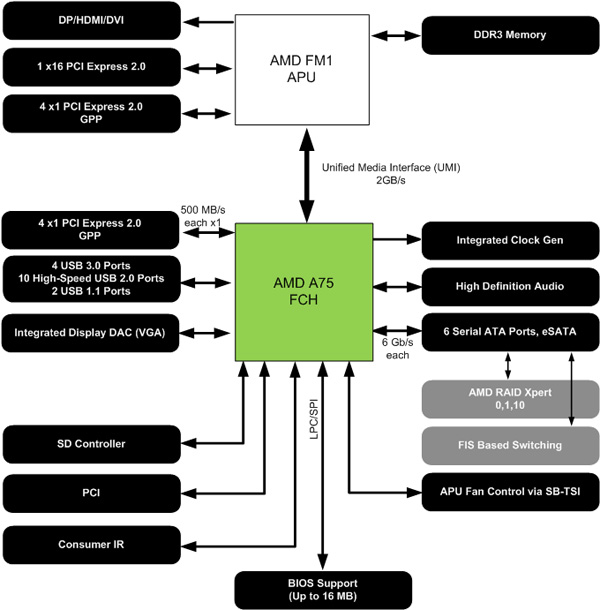
The A55 is the lower power, cost effective option that gets rid of all USB 3.0 support and backs down to 3Gbps SATA:
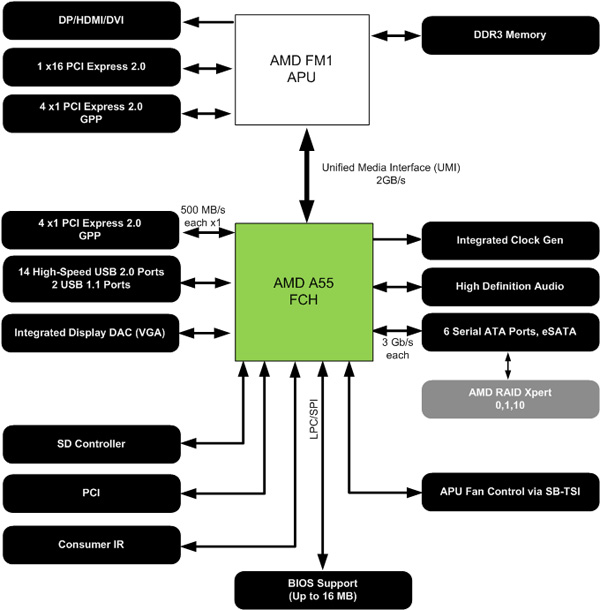


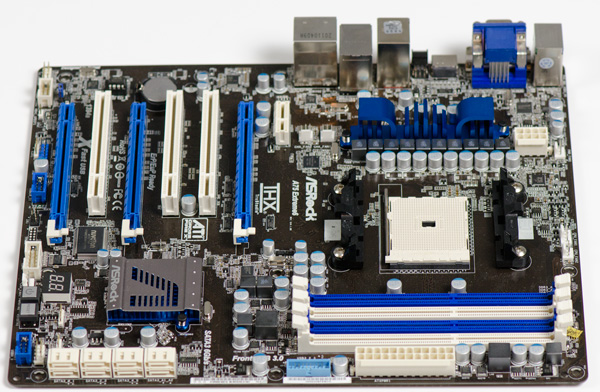
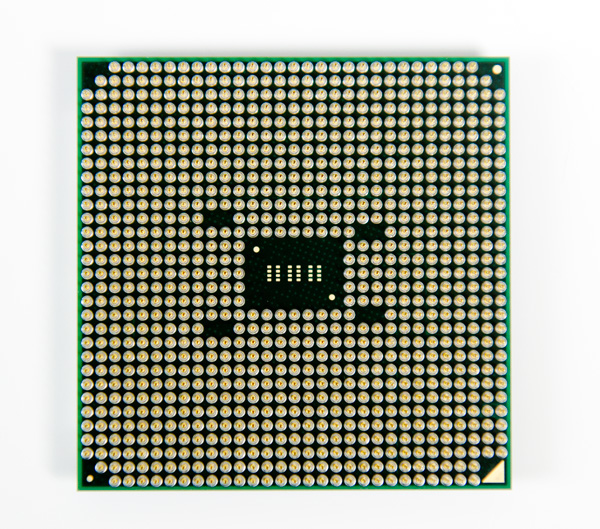
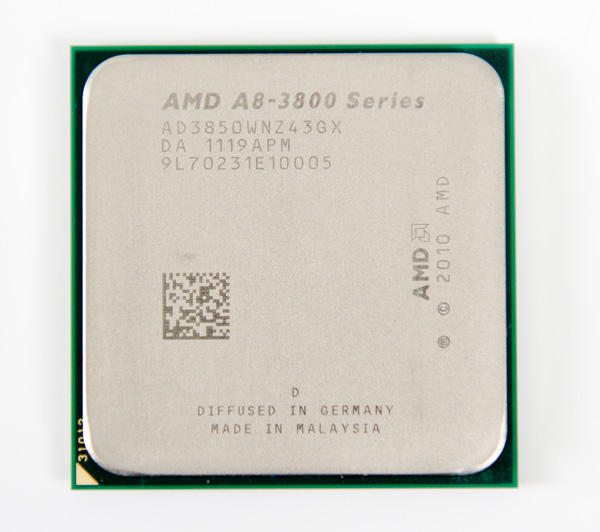
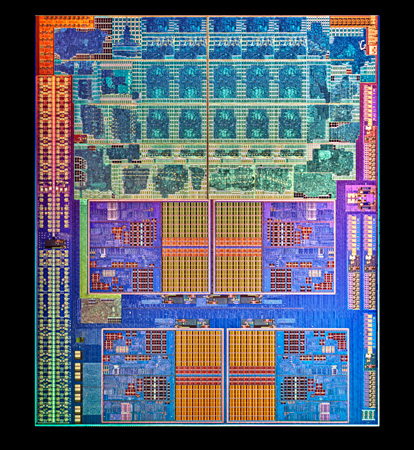








99 Comments
View All Comments
L. - Thursday, June 30, 2011 - link
Oh and to go further than that ... i3-2100 + CF6950 > i5+6970And yet here we are, buying i5-2500k's and saying its THE cpu to get .. lol
smartarse - Thursday, June 30, 2011 - link
Yeah, that's generally how things are done around here.Intel's CPU wins a benchmark by 5%? YOU MUST BUY THE INTEL CPU
Intel's setup uses 10w less at the plug? Clearly, any respectable human being would think of the planet
Core iX integrated graphics beat 890GX in 2 of 10 games? YOU MUST HAVE ONE NOW!!!!
Now, flip that around:
AMD ties Intel in a real world benchmark you actually use? You still want Intel for it's Sysmark score.
AMD is more efficient? Who cares about efficiency?
Llano integrated graphics win by 200%? Meh, we expected more, and graphics don't matter anyways.
HW_mee - Thursday, June 30, 2011 - link
I had to create an account after reading the review and comments.I have a two points that I hope people are open for a discussion about.
First of all, I believe Anand has missed the point of desktop Llano processors. The target platform seems to be laptops, and it really fits in the laptop market, while the desktop Llano processors seem to get low priority from AMD.
The desktop processors are useful as they provide a powerful platform at a low cost, which is an indication of the intended market for these parts.
The target consumer for the desktop parts seems to be OEM's, as they can now get rid of dGPU parts in AMD equipped machines in the 500 - 700$ segment, as this segment often features a Radeon 5450, Nvidia GT 430 or similar low end dGPU.
One less component to worry about is welcome news at any OEM.
Looking at Llano as a part for a home build, which I think is what Anand is doing in this review, makes it seem odd. Home build are designed to be very good at one or several points, single threaded performance, gaming, low power etc. The only point where Llano excels is idle power use, which nobody seems to care about, and delivering balanced performance with excelling or being particular bad at anything.
Second point I think should be discussed is peoples notion of what an average user needs in terms of computing power.
You guys are very demanding users and seem to expect a lot from the average user.
Going the list of people i know and their computers specification shows that none of them are even close to needing an i3-2100. the computers have a mix of single core Pentium M and ULV processors in the laptops and the desktops consist of a mix of old Athlons, post socket A, and first gen core processors.
These people are not even close to really stressing their processor. The two most common complaints from the average users I know is the slow harddrive and crappy Intel IGP.
I could write a lot more on this, including talk of SSD/dGPU being more useful than a powerful processor, but I think I have rambled enough.
HW_mee - Thursday, June 30, 2011 - link
Anand needs an edit button, just to allow editing for one minute after posting.I wanted to edit this part:
The only point where Llano excels is idle power use, which nobody seems to care about, and delivering balanced performance with excelling or being particular bad at anything.
to say:
The only point where Llano excels is idle power use, which nobody seems to care about, and delivering balanced performance without excelling or being particular bad at anything.
changing with to without makes a big difference :-/
L. - Thursday, June 30, 2011 - link
And for that ... we have the successor to e-350, the only APU that actually hits the spot. it's what everyone needs as HTPC, PC, laptop, work pc, ... all you like.And it's prolly as powerful as an Xbox360 anyway ;)
MrSpadge - Thursday, June 30, 2011 - link
As work PC? Glad you're not ruling my IT department!MrS
BSMonitor - Thursday, June 30, 2011 - link
"You guys are very demanding users and seem to expect a lot from the average user.Going the list of people i know and their computers specification shows that none of them are even close to needing an i3-2100. the computers have a mix of single core Pentium M and ULV processors in the laptops and the desktops consist of a mix of old Athlons, post socket A, and first gen core processors."
Ok grandpa, you sound like my 60y/o supervisor.
"in my day, a horse could get you everywhere you need to go"
Try running WIndows 7 and Office 2010 on a Pentium M. Not gonna be pretty. Try jumping on a web site with some Java or Flash.
YOUR point is that, "I never really use my PC except to look at pictures or lightly browse the interent". Well, why are you looking at a new PC for this if your Pentium M can handle it.
The point of ALL these articles is to decide what is the best available tech on the market right now. No one cares that you still use woefully underpowered machines to run windows 2000 and office 95..
L. - Thursday, June 30, 2011 - link
You sir . are unnecessarily offensive.If MS managed to make Office 2010 heavy enough to be an issue on anything above a p3, it's quite just another episode of "hey we can't code shit, but let's do it anyway, add some duct tape, paint it and sell it".
The point of the articles is to decide what is the MOST APPROPRIATE tech on the market for a USER's specific NEEDS.
In that, you sir, fail.
Most people only use facebook,youtube,gmail (or any webmail,really),some music player, some divx player (yes not everyone watches full HD x264 like me), and a few flash games or stuff.
Would you seriously state that an i3-2100 is REQUIRED for those tasks ?
BSMonitor - Thursday, June 30, 2011 - link
http://www.anandtech.com/bench/Product/71?vs=289And that Celeron is actually faster than an equivalent Pentium M.
Are you just stuck in a box? Software today cannot run on 5 year old hardware. Let alone 8y/o.
=
MOST people multi-task. You must be of the variety that sits at the computer screen and receives and email notification and thinks, "whoo that is cool, email.. who knew!"
==
OWNED
HW_mee - Thursday, June 30, 2011 - link
Great, lets try using that Celeron as a comparison point, I guess it is 4 times slower than an i3-2100, heck it is the cheapest Intel processor you could but 3 years ago, but even that is enough for a game of L4D, Fallout 3 or Oblivion.If you go cheap today and buy a dual core 2.X GHz, what task will you not be able to complete "fast enough" as an average user? You mention Encoding sound/video, but the average user just downloads that song/movie straight from the Internet.